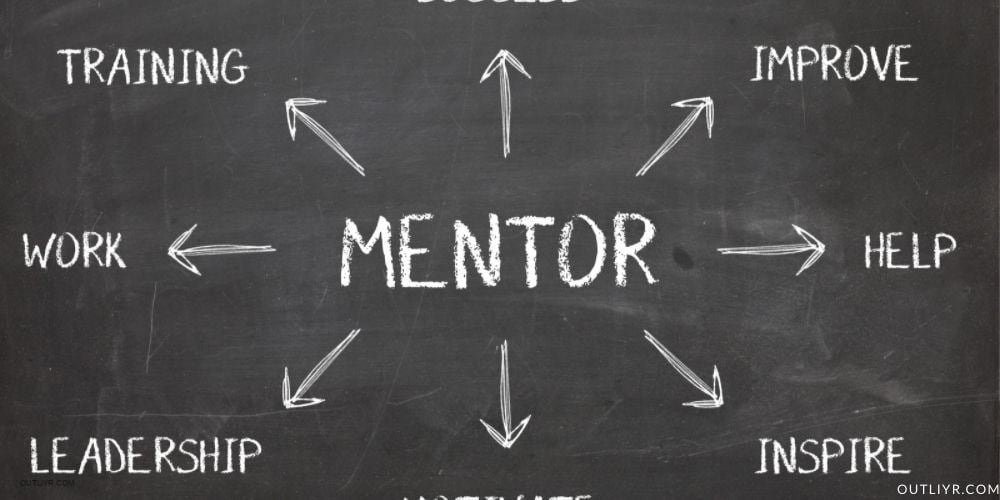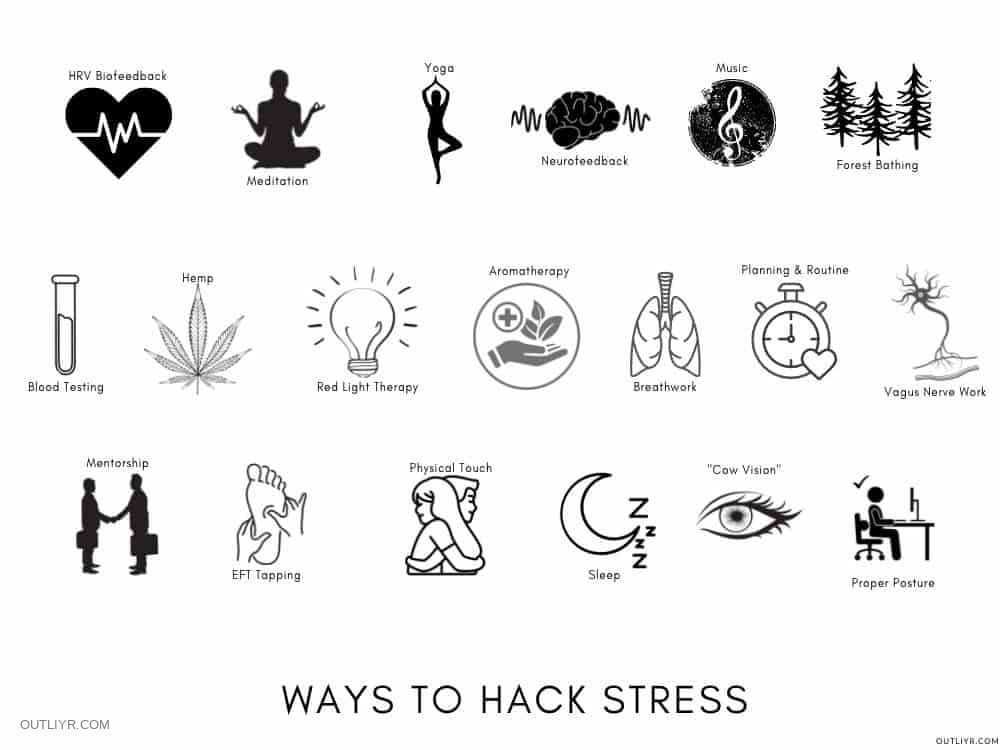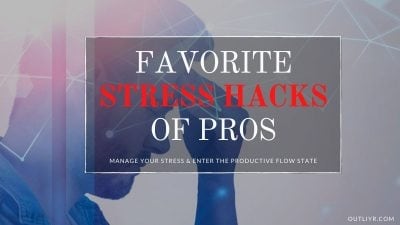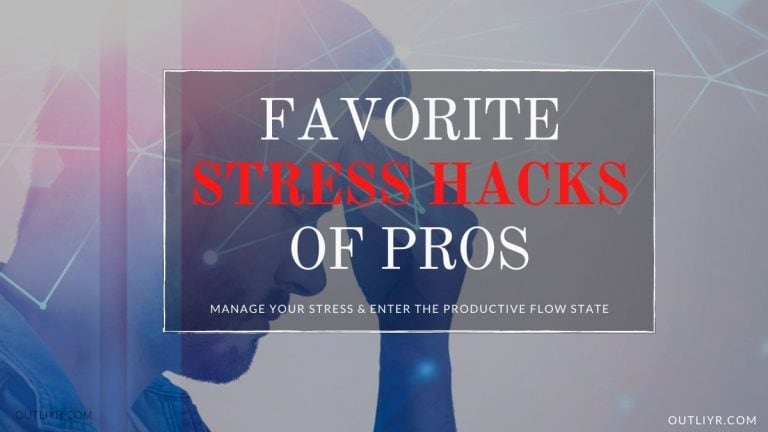One bodily system enables the human body to repair, regenerate, and grow. Our immune system. Just one thing deactivates it…
Stress.
Up to 95 percent of all diseases may be related to stress.
But it’s not just a disease.
Among the healthy, chronic stress can hamper the body’s ability to repair, recover, and thrive. I consider myself healthy and frequent blood work confirms it. So I wore a biometric-tracking device called the Nutrisense not expecting much. Yet Nutrisense highlighted stress management as a major area I need to improve.
And here’s the kicker.
Stress isn’t just from some big work deadline, or the loss of a loved one. It presents itself daily, often in invisible, silent, and unperceived ways.
Today’s post on biohacking stress will cover the following:
- What stress is and why it matters
- Measuring and quantifying our baseline stress
- Therapies and protocols to alleviate stress
- Supplements and ingredients to overcome stress
- Testing to see what’s working
- Engineering your ideal lifestyle
Let’s get started.
Biological Stress: A Silent Killer
Stress is a normal part of life. It keeps us alert and ready to protect ourselves from danger. In fact, research shows that bursts of acute hormetic stress exert profound health benefits.
But when stress becomes chronic, our bodies and brains suffer.
Chronic stress contributes to health problems such as:
- Neurodegeneration
- Heart disease
- High blood pressure
- Headaches
- Anxiety
- Depression
- Stomach disorders
- Skin problems
And it’s implicated in virtually every disease.
Unmanaged stress has a detrimental impact on our relationships, employment, and overall quality of life. Often it comes out in small outbursts, harshness, or a bad tone.
Top Tips to BioHack Stress & Live a Higher Quality Life
Fortunately, there are many things you can do to manage stress effectively. By understanding what causes stress and knowing how to manage your reactions to it, you can take back control of your life and reduce the harmful effects of stress on your body.
Some are free, or cheap, while others require an investment in specific gear. But it all starts with getting a baseline.
Blood test
Without measuring, you’re flying blind. No insight into what’s working.
Blood testing is a great way to get an instant snapshot of your current stress levels. It is inexpensive, noninvasive, and can be done from home using a finger prick or a simple blood draw.
Your body reacts to mental and physical stress in many ways. One of the most prominent is by modulating the stress hormone cortisol in the blood. You can measure it with a simple cortisol test.
Similarly, other tests can help you monitor your blood sugar levels and hormone levels, including epinephrine and DHEA, which are also related to stress.
I use a blood testing service called InsideTracker to quantify my stress levels. Blood lab work is the most important form of self-quantification.
Adaptogenic guardians

Adaptogens are a class of ingredients that, by definition, relieve stress.
In fact, they modulate bodily systems to increase our capacity to take on stress without degenerating.
Adaptogens build personal resilience by working with the body, rather than against it. They support all bodily systems, such as mood, cognition, sleep, digestion, detoxification, immunity, hormonal, and more.
“Taking an adaptogen is a little like getting a vaccine in that adaptogens prime the body to respond more effectively and appropriately to acute or chronic stress.”
— David Winston RH(AHG), Founder and President, Herbalist & Alchemist
One mechanism behind their effects is the re-regulation of the HPA-Axis and downstream molecules that ramp up cortisol production.
But that’s not all.
A quote from a popular study of these special ingredients succinctly describes how adaptogens confer their resiliency to the human consumer (emphasis mine),
“Adaptogens increase the state of non-specific resistance in stress and decrease sensitivity to stressors, which results in stress protection, and prolong the phase of resistance (stimulatory effect). Instead of exhaustion, a higher level of equilibrium (the homeostasis) is attained the heterostasis. The higher it is, the better the adaptation to stress. Thus, the stimulating and anti-fatigue effect of adaptogens has been documented in both in animals and in humans…”
Effects of Adaptogens on the Central Nervous System and the Molecular Mechanisms Associated with Their Stress—Protective Activity
So where to get started?
Some of my favorite stress-crushing adaptogens include:
- Rhodiola — a nootropic, physical performance enhancer, ergogenic energy aid, neuroprotectant, stress tolerance booster, and stress-buster (including inside the brain)
- Ashwagandha — 4,000 years of traditional use in India to alleviate deep exhaustion, reduce anxiety, lower stress, boost the adrenals, treat insomnia, and improve sexual performance
- Ginseng — notably used for stress reduction (suppresses pro-inflammatory cytokines resulting from chronic stress), increasing physical work capacity, to improve mood, enhance the brain, and mitigate anxiety
I take adaptogenic herbs, botanicals, and mushrooms most days to support my body’s optimal functioning.
Two of my favorite adaptogenic products include:
- CollaGenius (contains 1.2 pounds of functional mushrooms per serving)
- Stress Guardian (contains 14 highly potent and prized adaptogens)
Overall, adaptogens make you a more vital human. Because of their vast list of benefits with very few side effects, adaptogens make my cut of the best supplements for peak health and wellness.
HRV biofeedback
The best time to work on stress reduction is before the stress hits you.
HRV is a method that allows you to learn how to control your heart rate with your mind. It gives us a window into the autonomic nervous system (ANS).
The autonomic nervous system is the part of your brain and nervous system, that regulate unconscious functions like breathing, digestion, heart rate, blood pressure, immune function, hormone secretion, sleep cycles, and more.
Until recently, scientists thought that we couldn’t control the ANS. Simply because it takes special training.
HRV biofeedback, however, lets us “hack” our stress response. It works because changes in the time between your heartbeats are closely connected to the way your brain and body function.
The technique has been used by Olympic athletes for decades, but now it’s available to everyone.
I like a device called the HeartMath emWave 2, but my post on the best HRV biofeedback monitors lists alternatives for every budget and lifestyle.
EEG brainwave biofeedback

Brainwave biofeedback (also called neurofeedback) measures the electrical activity of the brain in order to determine what type of state you’re in. The goal is for you to produce that same frequency on your own without the device in high-stress situations.
Neurofeedback is like HRV training, but for the mind.
It’s a process that entrains optimal cognition by teaching you how to control your own brainwaves. By tapping into hyper-productive alpha and gamma waves, you can learn how to:
- Relax quicker
- Focus better
- Creatively approach problems
- Solve problems fast
- Quantifiably enhance meditation sessions.
It trains you to enter the flow state. Where you’re indistractable to the outside world.
Professional neurofeedback costs thousands and takes dozens of sessions.
You can practice these exercises in the comfort of your home with some modern technology. The best at-home neurofeedback device is the Muse S (Gen 2) headband.
Blue light
Blue light is a form of high-energy visible light that has very short wavelengths. This short wavelength creates a more powerful stimulation of the cells, and also stimulates production of chemicals in the body that can cause stress and anxiety.
At the right times of the day (morning and afternoon), natural blue light exposure plays a vital role in optimal health. But at night or before the sun rises, blue light disrupts the body’s processes.
This process has been shown to increase cortisol secretion, which is our primary stress hormone. Studies have found that higher levels of blue light exposure, directly and indirectly, lead to:
- Disrupted sleep and suppressed melatonin levels
- Mood problems and feelings of depression and anxiety
- Vision problems and retinal damage
- Decreased memory and recall abilities
- Greater difficulty paying attention and focusing
Where red light is dubbed the wavelength of recovery, blue is for concentration and wakefulness.
The strongest artificial concentrations of blue light are found in digital screens: computers, laptops, tablets, smartphones, and smart TVs.
Two good ways to eliminate blue light exposure at night are:
- Use orange-tinted glasses that block out blue light. I like the brands Ra Optics and BLUBlox
- Use software on your phone or computer that blocks blue light from emitting from your screen. I use IrisTech (see my review).
Blue light isn’t evil, but at the wrong times, it adds stress.
Skip the fast
I’m a strong advocate of regular fasting.
It helps the body recycle damaged organelles, clean up senescent cells via autophagy, and can even support rapid body recompositions (fat loss and muscle gain).
However, fasting is still a stressor. Each additional stress adds up.
When you’re under heavy stress, fasting—even intermittently for 18-hours—can accelerate HPA-axis dysfunction and eventually lead to burnout.
Don’t get duped by the feel-good catecholamines in your bloodstream. Keeping cortisol, adrenaline, and norepinephrine elevated until your feeding window can cause more harm than benefit.
During these days, try to eat three square meals. Pay special attention to keeping your blood sugar stable during your first meal of the day.
Plan your day
Stress is dread of a potential future.
Without proper planning, the mind will try to fill in the gaps with negative thoughts and worst-case scenarios.
You can only prepare for that which you know. Preparation ahead of time offsets stress.
Merely knowing what’s coming also reduces worry and increases the odds that you’ll accomplish your goal.
Plan your day the night before, and you’ll wake up with purpose, energy, and clarity. It’s also an easily accessible way to create control, further alleviating worry.
I use the following day planning process:
- Choose ONE vital outcome that, if you accomplish nothing else, would make the day a success
- Decide on another less important priority for the day
- Come up with one nice-to-have outcome
Your optimal day plan is challenging but completable. Make sure to celebrate your wins!
Reconsider stimulants
Most of us walk around with a chronically over-stimulated autonomic nervous system (ANS).
Stimulants like caffeine, nicotine, and others work by activating the sympathetic (“fight-or-flight”) branch of your ANS. When activated, it releases cortisol and other stress hormones. These hormones stay elevated long after you stop perceiving the effects.
Resulting in the characteristic feelings of energy and alertness.
This comes at a cost.
Stimulants, including coffee, are synthetic stress Click To TweetEventually, your body builds up a tolerance to stimulants; they don’t work as well anymore, and you need to take higher and higher doses to get the same effect. Tolerance can build quickly.
Every quarter I take a 10-14 day stimulant (mainly coffee) break to reset my tolerance.
To give your nervous system a chance to repair, check out this article on how to reset your stimulant tolerance.
Or, at least, lessen the burden of stimulants on your body with the following ingredients:
- L-theanine — the original nootropic — an amino acid known for smoothing out the effects of stimulants and increasing alpha brainwaves
- C8 MCT oil — the fat slows absorption and increases ketone levels. Supporting a cognitive and energy boost without the crash.
An added bonus, or perhaps the real reason I do it, is that when you restart your habit you’ll actually feel (and enjoy) your coffee again.
EFT or Apollo
Stress is all about perception.
For example, consider public speaking.
Some eagerly anticipate it, while the mere thought paralyzes others.
You can use the Emotional Freedom Technique (EFT tapping) to eliminate feelings of stress by reframing how you interpret a situation. EFT is a form of psychological acupressure — a fusion of Eastern and Western psychology techniques that uses touch to stimulate specific meridian points on the body while you think about an issue.
By simply tapping your fingertips in a specific sequence, you activate and balance meridian points.
EFT releases blocked energy from our emotional wounds; freeing our minds and bodies from toxic feelings like fear, guilt, anger, resentment, and jealousy.
Coupled with positive affirmations, EFT tapping can help reduce stress levels in your body significantly in just a few minutes per day!
Click here to learn more about the science and how to perform a special type of EFT.
Or you can use modern technology which simulates the same pathways and requires virtually zero effort. The gold standard is a device I’m currently testing. My Apollo Neuro Review unpacks the profound improvements it has made to my sleep, recovery, stress levels, and HRV. Ideal if you’re unable to tap or want constant effects throughout the day.
Move
When a deadline approaches, or I noticeably tense up, I make sure to move.
Whether it’s a ruck around the block, sprints (here is a guide on sprinting, its benefits, and how it works), a bodyweight micro-workout, or resistance training, I always return grounded and clear-headed.
Exercise releases beta-endorphins, which are small proteins that attach themselves to receptors in the brain and block the transmission of pain signals across the brain. Research suggests that these natural opiates are 3-10 times more potent than the pain killer morphine.
Endorphins also amplify feelings of pleasure and reward, so you feel better after working out than you did before you started exercising.
When you’re already under heavy stress, something simple like a brisk walk can relieve stress without added stress burdens.
The best plan involves easy “micro-movement” throughout the day.
Vision hacking
Your eyes are the only part of your nervous system outside the body.
Their position grants them the unique ability to quickly modulate your nervous system.
Several things can increase your stress response:
- Laser focusing on an object
- Bright light
- Flashing light
This stress occurs at the cellular level, you may not notice it.
At any point, you can focus either on a specific object or point in front of you. While I type this, for example, I’m staring at my computer screen. Ancestrally, this could signal a potential threat from a predator. The body responds by pumping stress hormones into the blood.
Alternatively, use “cow vision” and shift your attention to your peripherals and less on the objects directly in front of you. You’re not looking at any one particular thing. Rather, taking in the entire landscape (the room, a large field, etc).
Ancient humans would only use this widescreen view when safe.
Strategically altering my focal point works rapidly and effectively.
Music

We know that the right tunes can make a big difference.
Exercisers rely on hard rock, rap, and EDM to fuel grueling workouts.
While classical, jazz, house, indie, and smoother genres accommodate work and relaxation.
Several mechanisms behind the positive effects of music on stress include: dynamic range of the audio, tempo, “mode” or the scale of song, and rhythm.
I find one particularly interesting. The heart entrains with the rhythm of the beat. Songs with a slower tempo reduce heart rate, calming the nervous system and inducing relaxation.
Enjoying a song also decreases activity in the amygdala, which is responsible for our fear response. It triggers the release of calming neurotransmitters like serotonin and dopamine, leading to an overall sense of relaxation and well-being.
Listening to music can also increase blood flow to the brain.
In scientific literature, music therapy is gaining validation as a useful treatment for a variety of conditions.
Posture
You’ve heard that “sitting is the new smoking”.
It’s partially true. While better, swapping sitting with standing has issues.
If you are standing or sitting with poor posture, your body is held in a state of tension that doesn’t allow you to relax. When your spine is out of alignment, your nervous system perceives this as a threat to the integrity of the vertebrae. Your brain then releases stress hormones, causing muscle tension in an attempt to protect.
When we feel stressed, we start to feel uneasy and tense in the neck and shoulders. Staying stationary in any position creates tension in the musculoskeletal system. This tenseness can spread to other parts of our body, creating a cascade effect.
Your body begins normalizing tension and unnatural positions. A syndrome called forward head posture develops. When this happens, the body has more difficultly transporting blood, nutrients and electrochemical signals throughout the body. Resulting in a less efficient body.
Proper posture allows you to maintain proper breathing patterns and circulation. As a side effect of increasing alertness, you’ll have less desire for adrenal-taxing stimulants.
But proper posture isn’t standing ramrod straight with military neck and shoulders fully protracted. Ideal posture varies based on your unique body. YouTube has great resources.
Sleep
Recovery happens during sleep.
Dr. Matthew Walker’s research has shown that sleep deprivation makes us more emotionally volatile and less resilient to stress. Dr. Walker’s 2019 study showed that a single sleepless night can trigger a 30 percent increase in emotional stress.
Other research finds that inadequate sleep leads to neuroendocrine disruption, resulting in exaggerated stress responses.
One phase of sleep called deep sleep, can rewire your brain for relaxation.
Sleep also strengthens mood and life outlook.
Shoot for 7-9 quality hours, and use these tips to biohack your sleep.
Physical Touch
Touching other humans benefit your health.
Hugging, or even just minor contact alleviates stress via several mechanisms:
- Pressure receptors on the skin alter neurotransmitter and hormone levels
- Electrical modulation via heart coherence caused by standing within each other’s electromagnetic field
Research suggests that physical touch can:
- Reduce inflammation and pain
- Lower the stress hormone cortisol
- Normalizes other biomarkers
- Strengthens the immune system
It also buffers the damage caused by large stress responses.
Generously—and appropriately—dolling out hugs benefits both the hugger and the recipient.
Get a mentor

Mentorship is another little-discussed stress management tactic.
Both mentors and mentees gain from intentional collaboration. Mentors can help:
- Highlight unreasonable expectations
- Normalize problems
- Clarify optimal paths forward
- Provide new perspectives
Mentorship comes in many flavors: formal or informal, friend or professional, in the workplace or outside.
I believe that a major success of therapy comes from having a sounding board to bounce ideas and thoughts off.
Research supports the stress reduction benefits of mentorship too.
Intuitively, knowing that you can safely turn elsewhere for guidance helps soothe current stress.
Vagus Nerve work
The vagus nerve is tasked with controlling our alertness (put another way, our stress level).
To amp up relaxation, we want to shift the balance into a parasympathetic “rest and digest” state.
Popular practices that activate the vagus nerve include:
- Intentional slow breathwork
- Singing
- Chanting
- Humming
- Exercise
- Gratitude
- Massage
- Laughing
- Cold therapy
- Meditation
- Improving gut health
Notice that many popular healthy lifestyle practices activate the vagus nerve.
You cannot exist in both sympathetic “fight-or-flight” and parasympathetic “rest-and-digest” states simultaneously.
The more of the above modalities you build into your life, the better you’ll feel and the more resilient against future challenge.
Forest bathing & nature therapy
When possible, try taking a stroll through the woods, or enjoy a day on the beach.
Forest bathing is a Japanese practice that combines walking through the woods with being mindful of your body. It’s an eyes-open meditation where you focus on each of your senses.
Rather than clearing your mind before a walk as you might do during meditation, you can use these walks as an opportunity to meditate on what you see, hear, smell, taste, and touch as you pass through nature.
This kind of meditation helps bring you into the present moment as well as relieve stress and help you gain more appreciation for nature.
Even us city dwellers benefit from a quick stroll into our nearest park.
It’s not just from being outdoors and in sunlight. Research has shown that symmetrical patterns omnipresent throughout nature (called fractals) can reduce stress levels by up to 60 percent.
Gratitude

Gratitude is one of the most important states to regularly tap into.
Expressing gratitude, causes our brain releases to release feel-good neurotransmitters dopamine and serotonin. The more we strengthen these neural pathways, the more resilient we become against stress.
It improves happiness, optimism, sleep, mood, outlook, buffers against negative states, and directly causes well-being.
As mentioned within the vagus nerve practices, it has calming effects on the nervous system. Particularly relevant are the studied anti-stress benefits of gratitude, including increased production of the relaxation neuropeptide oxytocin.
Gratitude even changes how you experience stress.
Scores of clinical trials display the anti-stress effects of gratitude. Many thousands of articles highlight the profound improvements to overall wellbeing.
A gratitude practice can be simple.
Upon rising, think of three things (preferably different each time) that spark joy. Remember, you can always find something to be grateful for, even if it’s just having two arms.
Life becomes easier and better when you practice gratitude.
Breathe
Learn to breathe properly.
Breathing deeply is a great way to build tolerance to stress and quickly alter your state.
Contrary to popular belief, rapid breathing doesn’t actually saturate the body with oxygen.
Thanks to the Bohr Effect, paradoxically we know that increased carbon dioxide (CO2) allows red blood cells to carry more oxygen.
The issue?
Rising the blood’s CO2 level feels uncomfortable. Panic-inducing uncomfortable.
Breathwork practices like Wim Hof teach our bodies to tolerate increased CO2 and thus relax under stress.
It’s not just this “inner fire” style of breathing that builds resilience to stress. Other famous relaxing breathwork practices include:
And many more.
You can start simply. Notice areas of tension throughout your body. Do a short inhale, followed by a longer exhale, consciously relaxing contracted muscles.
Or just slow down your breath to six seconds inhales followed by six-second exhales. Research finds that deep breathing improves both subjective and objective stress and mood.
See the following article for information on how to breathe properly.
Deliberate breathwork lowers your heart rate and improves your ability to think rationally. Start out by practicing when not under pressure.
You can control your breathing anywhere, anytime, and immediately feel grounded and less affected.
Meditate
One of the classic symbols of destressing, meditation quickly alters your brainwaves and puts you into a more relaxed and coherent headspace.
Modern QEEGs show levels of the stressed beta brainwaves begin declining in as little as 50-seconds. Instead, it shifts into the brainwaves associated with peak performance (alpha, theta, and gamma).
Meditation isn’t about “quieting your mind”. An evolutionarily preserved structure of our brain called The Default Mode Network fights the quieting.
For the skeptics, impatient folks, or “failed meditators”, I recommend one of two practices:
Whether you’re a hard-charging Type-A personality or a Zen Monk, I regularly hear stories of astounding success with these two. Dr. Dawson Church’s research shows unbelievable improvements in as little as two sessions.
And his brain scans show that experienced meditators following EcoMeditation can drop into bliss states in as little as 50-seconds. States characterized by your internal pharmacy pumping out molecules of ecstasy (anandamide, oxytocin, dopamine, serotonin, beta-endorphins, norepinephrine, nitric oxide, and more).
For an even simpler approach, when I simply become aware of the origin of my thoughts, I usually see a different perspective to the situation. My tension melts away.
Often, the difference between nervousness and excitement is mere perception.
Every time you meditate, you re-wire your brain. Inoculating yourself against future stressors.
Yoga

Here’s something to ponder:
Stress follows tension. Not the inverse.
By paying attention to each of the muscle groups, we can consciously relax them and dissolve the stress.
Picture a yogi. What associations come to mind? Zen? Chill? Loving?
Yet another cliche symbol of relaxation, but with good reason. Yoga has rapid and profound physiological impact.
It’s believed to work on the hypothalamus (a control center of the brain) by reducing cortisol secretions. This may be one mechanism that explains its anti-depressive benefits.
Yoga is also well documented to relieve worry and stress in subjects of all ages.
Like meditation, yoga appears to impart lasting changes that increase personal resiliency and ability to regulate the sympathetic and hypothalamic-pituitary-adrenal (HPA axis) systems.
But these revitalizing yogic movements aren’t limited to the classic in-studio classes.
Any low-exertion activity that brings your awareness to areas of tension in the bodywork similarly.
Holistic health practitioners call this “working in” (as opposed to working out).
Red Light Therapy
Light is well known to quickly shift our state.
Blue light stimulates the production of the stress hormone cortisol (SAD lamps do this in the morning to boost mood and increase alertness).
Sit in front of a red light panel for 15 minutes, and you’ll quickly feel your physiology changing. That’s because red has the opposite effect. In normal amounts, it blunts cortisol. Mouse studies have shown exactly that.
One mechanism it works through is by dilating blood vessels. Red light also works by boosting the feel-good neurotransmitter called serotonin (at least in mice).
One study of laser irradiation (LI) found a positive impact of light therapy on both acute and chronic stress,
“A low level LI (LLL) cannot directly affect a normal function, but can modulate a chronic stress. A normal function may have a chronic ordinary stress, and an LLL may modulate the chronic ordinary stress so that it promotes the normalization of the dysfunctional FNS and then upgrades the normal function.”
Photobiomodulation on Stress
Research suggests that this therapeutic light (also called photobiomodulation), even has potential for improving anxiety disorder and post-traumatic Stress Disorder (PTSD).
Best of all, you can easily “stack” red light with other stress management practices.
Aromatherapy
I considered essential oil aromatherapy “woo” for most of my life. Then I burned my mouth on a single drop of oil of oregano.
I’d previously heard the fabled benefits, but burning my mouth convinced me to dig into the research. The more I looked, the more I found.
Specific essential oils have uses for everything from boosting cognition (memory, focus, and brainpower), to improving athleticism, to reducing pain.
Some of my favorites and popular oils include:
- Lavender — a floral scent that’s great for sleep, relaxation, calmness, and more
- Peppermint — an oil I use daily for energy, clarity, and to stimulate the body
- Frankincense — a sweet and musky aroma shown to help rats manage stress, and significantly reduce anxiety in humans. Sometimes considered the “king of essential oils”
- Bergamot — a citrus aroma known for alleviating worry, reducing stress, and inducing relaxation
- Orange — a meditator’s favorite, with a sweet scent, anxiety blocking effects, and heightens the senses
One study of the effects of bergamot essential oil on the youth concluded,
“Aroma inhalation could be a very effective stress management method for high school students”
The effects of aromatherapy on stress and stress responses in adolescents
See this HealthLine article on the Top 10 Essential Oils for Stress, and the research backing each.
But these oils can get pricey, and typical diffusers chew through an entire container in mere hours.
Instead, I use a portable wooden inhaler (it looks like a small pipe) to extract the full benefits out of my oils, and at the same time, I get to enjoy the process.
Read my Fum Inhaler Review and get an exclusive deal on your own with code URBAN.
Hemp & CBD

Cannabis is one of few compounds that has an entire bodily system (endocannabinoid) named after it.
THC has become the most famous of the 130+ different cannabinoid molecules contained within cannabis. The vast majority do not have psychoactive effects.
The endocannabinoid system (ECS) primary maintains homeostasis throughout the body. It does this by exerting adaptogen-like effects.
Modulating and bringing out of balance hormones (cortisol), neurotransmitters (GABA), and peptides (insulin) back into healthy balance.
After THC, CBD is most widely known and used therapeutically. Users praise it for drastically improving a wide variety of symptoms. CBS is but one of many. Others include:
- CBG
- CBC
- CBCA
- D-8-THC
- CBGA
And many more.
Note that THC often has the opposite effect — increasing cortisol and paranoia (in some users).
Cannabinoids can have powerful effects on the body. Reducing cortisol, boosting stamina, speeding up recovery time, and increasing neurotransmitters associated with calmness, rebuilding, relaxation, and growth.
Some of my favorite relaxation products come from a company called Troscriptions.
- TroCalm — a deeply relaxing blend of hemp extract, botanicals, phGABA, and kava
- Blue Cannatine — a brain-boosting nootropic stack of methylene blue, low-dose nicotine, caffeine, and hemp extract
But you can stimulate your ECS naturally too:
- Avoid pesticides
- Optimize omega-3 intake
- Fast
- Exercise
- Reduce stress
- Cold thermogenesis
- Caffeine
I make my own cannabinoid tincture (sans THC) and, in addition to calming me, it massively improves my sleep quality without forming dependence.
Sex
No list of stress relief is complete without mentioning sex.
As I mentioned in my article on the therapeutic benefits of physical touch, hugging, and personal connection, connection is one of Earth’s most powerful stress buffers.
Mere physical contact with a stranger exerts some benefits. Due to heart coherence, the effect is especially strong if your counterparty is in a calm, relaxed state themselves. Emotions and feelings are contagious.
Sex is the next level, and acts as a natural stress reliever through several mechanisms:
- Increased oxytocin
- Increased endorphins
- Other hormones contained in semen
- Breathwork
- Physical tension relief in the hips
- Sense of connection
- Exercise
Chief on this list are oxytocin and endorphins.
Endorphins chemically resemble the structure of the powerful drug, morphine. Indeed, many studies have shown that these internal chemicals act as natural pain relievers, mood boosters, and enhance the connection between partners.
Autonomous Sensory Meridian Response (ASMR)
If you’ve wondered about the trend of people whispering in YouTube videos, you’ve likely seen this.
Autonomous Sensory Meridian Response (ASMR) is the scientific name for the tingling sensation across your scalp or back of the neck that you get from certain stimuli.
Enthusiasts describe it as a soothing feeling resulting from a particular trigger. Common ones include:
- Whispering
- Personal attention
- Sounds
- Slow movements
Several studies investigating the phenomenon have found that it induces a “flow-like mental state” providing notable but temporary pain, stress, and depression relief. In the same study, a whopping 70% of subjects reported using ASMR to deal with stress.
I personally don’t feel the touted effects from ASMR videos, but sometimes experience similar sensations in everyday life.
How to Biohack Stress to Build Resiliency

“75% of doctors visits are stress related”
— Dr. Mark Bubbs
Stress is not a performance advantage. Living on edge will not propel your career and life to new heights.
Do you ever wonder how certain individuals accomplish great feats in a single lifespan?
Flashes of insight just come to them.
Careful analysis has shown that many of the world’s most prolific inventors and successful businesspeople learned to tap into a hyper-productive and abundantly creative state of mind called the “flow state”.
Research has proven that stress blocks your ability to enter this state.
In modern living, rampant levels of the stress hormone cortisol play a major role in damaging and degrading the body.
We wrongly vilify the acute stressor. It’s chronic stress that results in degeneration, sickness, and disease.
Stress dysregulates virtually every process in the body. Including:
- Brain function
- Hormones
- Sleep
- Vision
- Mood
- Immunity
- Weight gain
- Organ health
- Digestion
- Energy level
But you can stop it.
Use the dozens of free, cheap, and state-of-the-art anti-stress practices, tools, and technologies listed in this post.
Choose a few—or just one—and schedule it into your calendar with the same priority as any other meeting or must-do.
Commit to following through and making it a proper quantified self-experiment. Record your baseline. Then take notes and track your progress for a week. At the end, compare notes.
You can even try removing the stress management strategy. Compare how you perform and feel to before.
How do you biohack stress? Let me know your favorite tools and tactics in the comments below!







